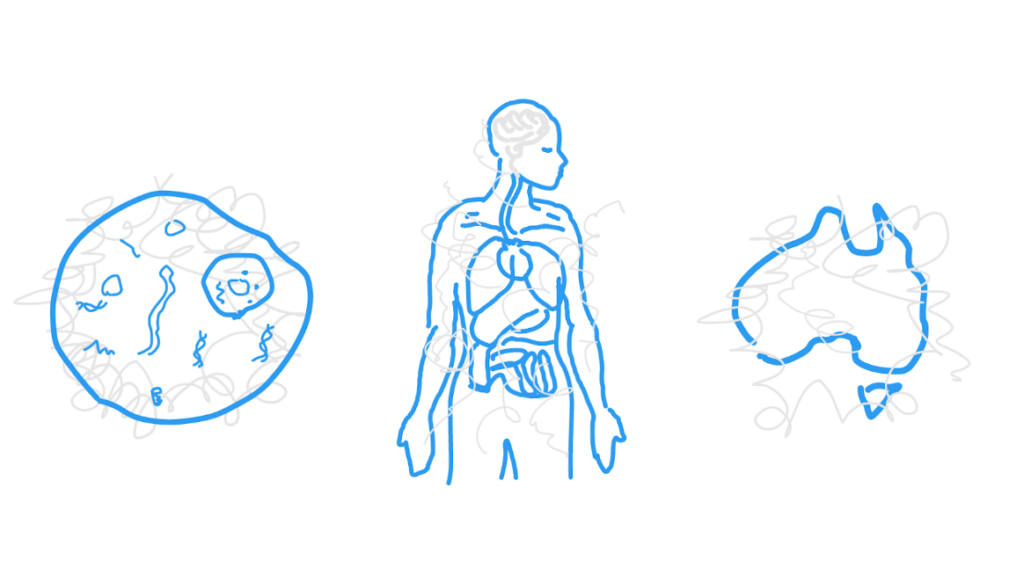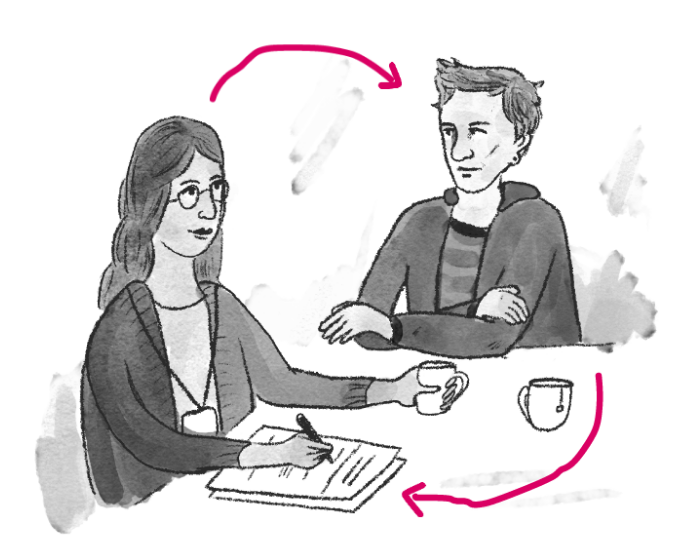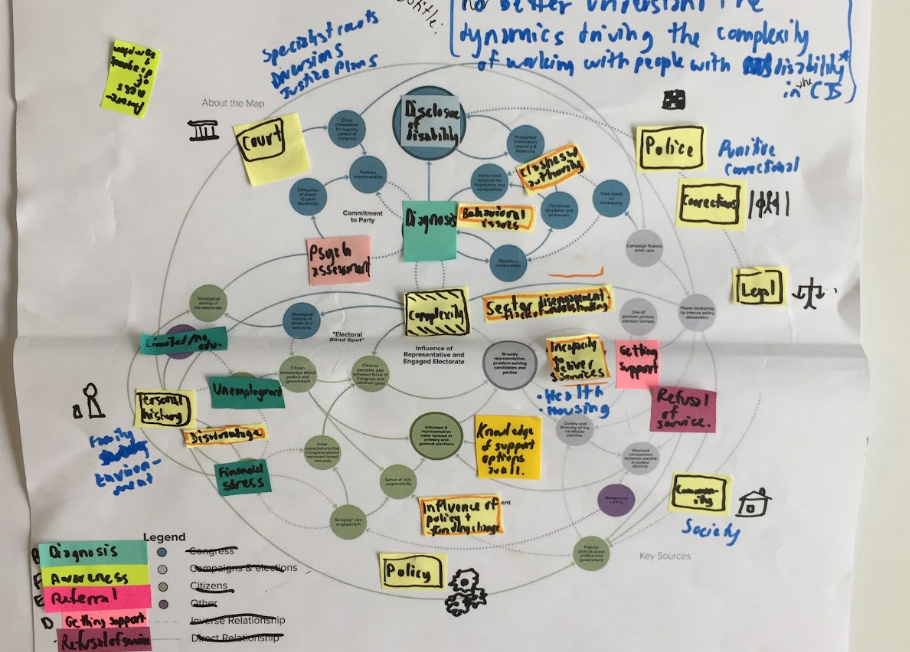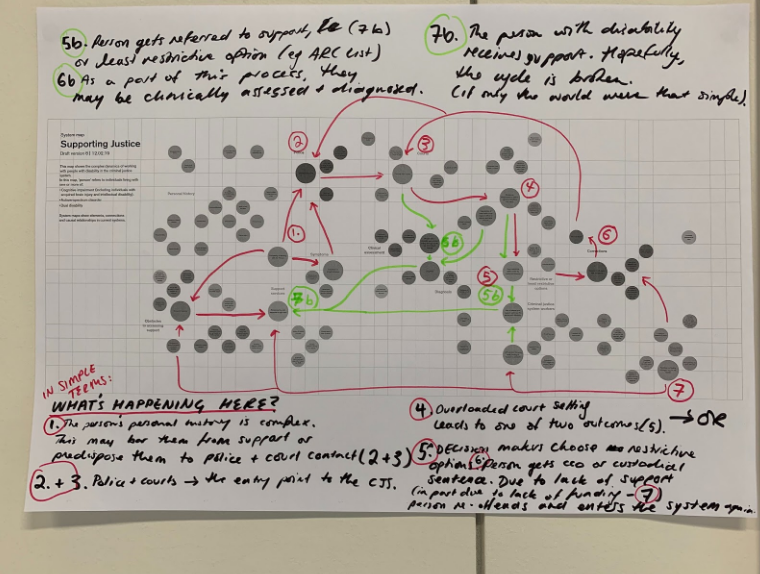Untangling complexity with systems thinking: how to see the water
The following is a transcript of a talk I gave at Service Design Canberra, September 2018
I’m Reuben Stanton, I’m the managing director of Paper Giant. Thanks Priyanka and Bec for the lovely introduction, and for Service Design Canberra for hosting this great event.
I’m going to start with a water metaphor – a quote from anthropologist and anarchist David Graeber – any David Graeber fans here? And the quote is:
“Why hire someone to fix the leaky roof when you can just hire someone to keep switching buckets and mop every hour?
— David Graeber 1961-2020
I like this quote because it speaks so clearly to what I see as an issue with approaches to problem solving across the government, private sector and social sector.
In my experience, short term symptomatic solutions are often prioritised over real, lasting, systemic change. This might resonate with some of you here.
I’m here to talk about untangling complexity with systems thinking’
That’s because we are operating in a world where there is growing complexity and interdependence of modern societies and economies, which depend on more and more complex infrastructure, platforms and rules to work properly.
And by properly I mean in ways that are fair, just, and sustainable.
You can ask yourself: the world fair, just and sustainable right now?
And it seems to me, that the predominant tools of design – including maybe even Human Centred Design, haven’t been working all that well to get us out of this mess. Maybe there’s more that we could do. Maybe systems thinking could help?
First, I should explain what we mean when we talk about a ‘system’.
A system is anything that includes a number of parts interacting to achieve a certain goal. For example:
A human cell is a complex system made up of a cell wall, cytoplasm, a nucleus, rna, dna, mitochondria and much more – all of these parts interact to keep the cell functioning.
Your body is a complex system, made up of cells, organs, chemicals, electrical currents, symbiotic bacteria, and much more – all of these parts interact to keep you healthy and alive.
A country is a complex system, made up of people, policies, infrastructure, geographies, an environment, and rules, – both explicit and implicit – , technology and much more – all of these parts interact to keep it sustainable and livable and safe and thriving.

Complex systems are highly interdependent – which means that different parts of the system interact to create effects, and it can be very hard to predict how affecting one part of the system will affect the rest. Even just in these three examples, you can see that complex systems nearly always depend on other complex systems for inputs to make them function.
Systems thinking, or systems practice (the two seem to be used interchangeably) is a set of principles, tools and methods to help you consider how systems work, how different variables interact, and how changing one part of a system might help, or hinder you, from achieving a certain goal.
Underlying any system is a mental model of how we think the system works – our assumptions about the way things just are. Usually these mental models are implicit – we don’t even know that they are there.
Here’s another water metaphor – a parable that’s used a lot in systems thinking goes like this:
One morning, a fish is swimming along. It sees another fish, a good friend of his. His friend swims up and says “Hey, how’s it going? How’s the water?”
The first fish stares back blankly at the second fish and then says: “What’s water?”

It’s hard to see the water we are swimming in – we sometimes don’t even notice it’s there.
Systems thinking helps you see the water.
Often when we talk about systems thinking, we are really talking about System Dynamics – a methodology for building formal models of complex systems. That’s mostly what I’ll be talking to today, and what Priyanka will be working through with you in the workshop later.
There are lots of different ways to build these models, which I won’t go into today for the sake of time, but in essence it’s about making diagrams, that map assumptions about systems, to build the model.

This model, in turn, allows you to make better decisions that are (hopefully) based on a more accurate picture about how things actually work in the world.
Systems thinking is also a bit different to more common design approaches to change, like the double diamond or service blueprinting.
Design often talks about ‘solving problems’ – it’s right there on Paper Giant’s website even. This is a view, which sometimes limits you to mitigating symptoms that you notice as I mentioned earlier.
The designer might notice the water at their feet and ask: “how might we create a better mop?”
But systems thinking is a bit different, as in systems thinking we aren’t looking for solutions – instead we are looking to generate a system that works to create better outcomes – it’s an important distinction.
- Systems thinkers aim for ‘systems health, not solutions’.
- The aim to ‘see patterns not problems’
- Systems practice about unlocking change, using a system’s own emergent dynamic properties.
- And like design, systems practice should expect to adapt and change – as the system changes around you, you need to adapt your approach as a well.
This might sound a bit vague, but I’ll hopefully make this a bit clearer as we go.
A case study: the Supporting Justice Project
So – rather than talk you through the ins and outs of systems theory in what is a relatively short talk, I’m instead just gonna take you through a case study – some work we did at Paper Giant last year, which I hope is illustrative.
It also just won a good design award, which we are quite proud of.
Here is a fact:
‘“33% of women and 42% of men in Victorian prisons have been found to have an Acquired Brain Injury (ABI), compared with 2% in the general Australian community”
What does this mean? It means that people with this disability are overrepresented in our prisons. This is an indictment on our society! This is societal and public policy failure! Effectively, prisons have become the de facto social service for people with complex support needs.
This doesn’t sound like a healthy society to me!
Another stat:
People living with disability aged 35-54 are incarcerated at twice the rate of those without disability.
These are people that should be protected and supported, and should be getting the highest levels of supported care through systems like the NDIS. And yet, here we are, locking them up.
I think we should fix this. Because this is terrible!
Why should we fix it? Well – you can make an economic argument if you like (though I don’t like to, because economic arguments risk locking you in to doing things just because they are cheaper, not because they are the right thing to do)
But you can – if you want to:
In the last Victorian budget we spent 1.9 billion dollars on prisons.
Just think about what we could do with that money.
Here is an argument I much prefer.
“Injustice anywhere is a threat to justice everywhere”
– Martin Luther King Jr
We should fix this because it’s the right thing to do!
If we want the justice system to work better, something needs to change.
Ok. How?

We all operate within a wider context of people, organisations, technology, policy, and many other factors, that make certain outcomes more likely. The criminal justice system is a system.
We needed to look for patterns, not just problems. We needed to unlock change by seeing the patterns.
So – in this project, we, along with the centre for innovative justice at RMIT, got together a whole lot of stakeholders in the justice sector, including people with lived experience of cognitive disability and justice involvement, to help map how the system works (or, actually, how it doesn’t work to support human rights of people with disability)
We started mapping causes and effects.

We were asking: what caused a bad justice outcome for a person with disability? And what caused that? And what caused that? And Why did this thing happen? And who made that decision? And how? And why?
After many iterations, after 100s of conversations and disagreements – we arrived at something that seemed to make sense to everyone – people who’d lived through it, expert lawyers, police, criminologists, care workers, magistrates – this map showed how it all connected.
As you can see – it’s not simple! There was no one cause of a problem – it was a series of interconnected factors that all led to bad outcomes overall.

“Structures of which we are unaware hold us prisoner”
– Peter Senge, the Fifth Discipline
And just like that, people working in the criminal justice system started to notice the structures that were holding them in place – they started to see the water.
This kind of mapping is great at showing how situations, events and outcomes have more than one cause.
It helps you tell complex stories about the system.
What kind of stories?
1 – A person’s history might be complex. This can predispose them to contact with police and courts. It also renders them eligible or ineligible for certain support services.
2– Police contact is usually a person’s entry-point to the criminal justice system.
3– During the person’s journey through the criminal justice system, decisions are made about them that will be either more or less restrictive.
4a – If decision makers choose restrictive options , the person with a disability may end up with a corrections order that is difficult for them to follow, or a custodial sentence (so, prison).
5a If there is a lack of support, the person can end up re-offending and coming back into contact with police and courts. Which subsequently increases the likelihood of restrictive options being considered for the person. The map loops back on itself – this is a vicious cycle that leads to the gross overrepresentation I mentioned earlier.
But!
4b If decision makers choose less restrictive options, such as a therapeutic court or connection to a support worker, the person has a higher chance of receiving support.
The use of less restrictive options may enable the person to receive the right support at the right time, breaking the cycle of justice involvement.
This is not the only story in the map. But it’s a useful one. And it was really hard to see without the map.
This is a very different thing to making a journey map or service blueprint of the criminal justice journey, which might have shown where things were bad, but not why.
I want to draw out that distinction a bit, because it’s important.
Journey maps Show a ‘first person’ perspective of the experience of an individual within a system – they show what happens in a system with a human-centred perspective
By contrast, Systems maps trace the sequence of cause and effect through system, and map outcomes that have multiple causes – they show why something happens in a system with a holistic perspective
“Cause and effect are not closely related in time and space”
– Peter Senge, the Fifth Discipline
And this matters a lot. Because sometimes a ‘pain point’ for an individual in a system is far removed from its root cause. Also causes are effects, and effects are causes of other effects in the system!
And that’s really important, because it means that often, without systems work, you can’t actually prevent a problem, because it’s cause is too far away from your purview to see.
So what?
With the map, we could see where small changes, sometimes quite a long way from the problem, would have massive flow-on effects.
We identified three areas where small interventions would change how people with disability are treated in the system, leading to higher likelihood of better, and more just outcomes.
Carriage of information – to ensure that information about someone’s disability was actually transferred through the system
Spotting the signs – training people to identify people with hidden disabilities like ABIs
Use of supports and referrals – giving justice workers the tools they need to actually make referrals to the right services, before it’s too late
This is possibly the most important part of systems practice – The concept of leverage: small focussed actions can have significant, enduring effects, if they are in the right place.
We were able to ask ourselves: what are the causal factors of the bad outcomes we’ve identified? what reinforces them? What makes change hard?
Or – very importantly – what might make change easy?
How do we act once we know we’ve identified where the leverage is?
Now, we design.
Systems thinking gives you tools to understand how complex things interact with each other, so that you can make some good bets on what to change to create a healthy system.
Design thinking gives you the tools to make those bets: to intervene in the system, evaluate the change, and iterate as you go
So we took these leverage points, these intervention points – and we started a process of co-design and iteration to solve for problems at those points, knowing that if we fix things there we could fix things elsewhere.
Co-design was really important too – we can speculate all we like about possible solutions, but it’s the people closest to the problem who know what’s not working for them, who know what it’s like to be in prison, who know what it’s like to not be heard, to not be understood, to have your human rights ignored. This still had to work for a person in the system.

Systems thinking untangles complexity in so that it’s not just understandable, but actionable.
You can combine systems thinking and design thinking, because design thinking helps you take action.
Here’s just a few actions we took:

Yes, we co-designed some paper forms. But some really specific paper forms. They help lawyers and magistrates spot the signs of disability early, communicate appropriately so that people with cognitive disabilities can understand them, and refer clients and defendants to the right supporting services.
We designed online tools to help workers (such as lawyers or social workers) who help people with disabilities through the system, to help them find and direct people to the correct support.
We also designed training packs for magistrates and other justice workers to educate them about how to effectively work with people with disability – this has become part of the training and resources given to magistrates and lawyers across victoria.
Magistrates have said that as a result of this training, and the advocacy work that CIJ is doing off the back of this project – that they are actually changing how they interact with people and how they are sentencing people
There is more to this too of course, I encourage you to check out supportingjustice.net if you are interested in the outcomes specifically.
We also had a working theory of change and ongoing developmental evaluation to track emergent change in the system.
I can almost guarantee that these design interventions are not the ideas we would have had if we hadn’t done the systems mapping work. That’s important.
What’s also important is that the process of mapping with people involved in the system – using the map as an excuse to get people who wouldn’t normally work together in the same room as each other, sharing their challenges with each other, empathising, and agreeing that they needed to work together to change the system together – that’s where the power in this really lies.
Systems practice is about getting everyone to stop working on their immediate symptoms, and to work on removing negative causes and amplifying positive effects. The work of systems mapping itself can change the system.
ok,
That’s the end of the case study. It’s a specific context, but I hope it was interesting and illustrative.
Why does this matter?
Because we all work in, or with, complex systems. Any public sector workers here, this very much so – the government is a massively complex system, and interacts with the massively complex system that is the whole of Australian society and culture, state and territory governments, local governments, and the systems of global trade, global finance, and geopolitics – and much much more!
Government departments are complex systems themselves. Getting a good policy outcome, by definition, requires a systemic approach.
And if you don’t understand how systems work and interact, you are never going to find the right lever to pull that will actually make things better.
Systems thinking is primarily a tool to help you think and act holistically, to not get caught up working on ameliorating symptoms in your immediate context. It helps you to see the bigger picture in ways that untangle complexity.
If you want to stop working on the symptoms, and work on the causes… if you want to fix the problem of the dripping water pooling at your feet… maybe try looking up.
Thank you